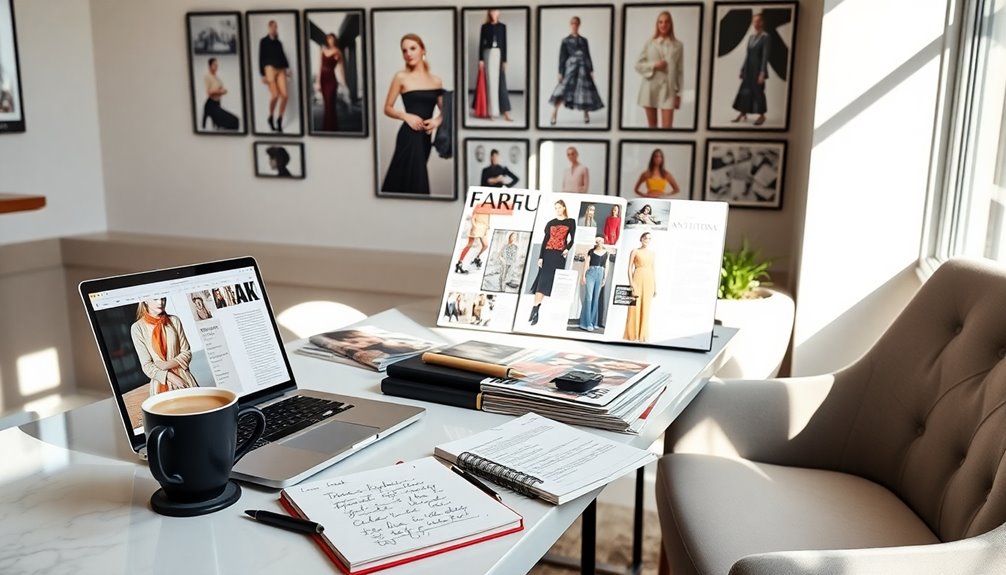To become a successful fashion editor, you'll need a solid educational foundation, usually a degree in journalism or fashion studies. Gain practical experience through internships to build a strong portfolio that showcases your talent. Stay updated on industry trends and hone essential skills like writing, editing, and photo shoot management. Networking is vital, so attend fashion events and engage on social media to connect with industry professionals. As you navigate your career path, each step you take will shape your expertise. You'll find that more insights and strategies can help you along your journey.
Key Takeaways
- Obtain a relevant bachelor's degree in journalism, communications, or fashion studies to establish a strong educational foundation.
- Gain practical experience through internships at fashion publications to build a diverse portfolio showcasing your writing and editing skills.
- Stay updated on industry trends, including sustainability and consumer behavior, to enhance your editorial insights and relevance.
- Develop essential skills in photo shoot coordination, Adobe Photoshop, and effective communication to excel in managing editorial projects.
- Network at industry events and leverage social media to connect with professionals and showcase your work, building a strong online presence.
Educational Background Requirements
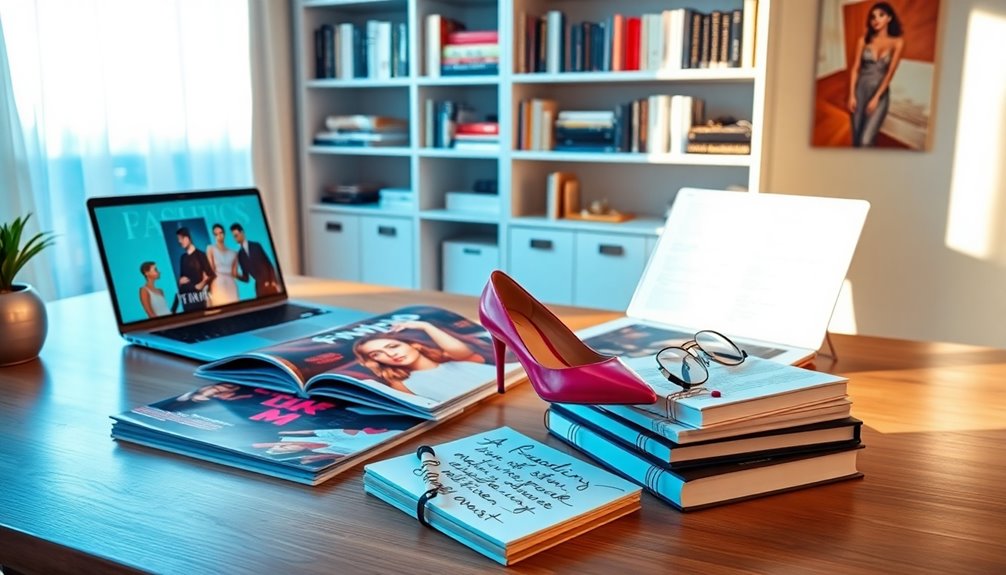
To become a fashion editor, you'll typically need a bachelor's degree in areas like journalism, communications, English, or fashion studies. This foundational education equips you with essential writing skills and industry knowledge. While a master's degree can enhance your qualifications, it's not a requirement. Degrees in graphic design or specialized sales and merchandising also provide relevant insights for your career.
Taking the right courses during high school, such as English, journalism, and communications, is crucial for honing your writing abilities. Classes in family and consumer science, along with foreign languages like French or Italian, can offer a broader perspective on fashion's global landscape. Courses in family and consumer science provide insights into fashion design, which is beneficial for aspiring fashion editors.
Accredited programs, like those offered by New York University, Parsons School of Design, and the Fashion Institute of Technology, are highly regarded in the field. Specialized programs, such as NYU's Fashion and Media program, combine journalism with fashion studies, giving you a competitive edge. Additionally, postsecondary courses in fashion design and marketing are strongly recommended. Developing strong writing and editing skills, along with creativity and trend-spotting abilities, will set you on the path to success in the fashion industry.
Gaining Editorial Experience
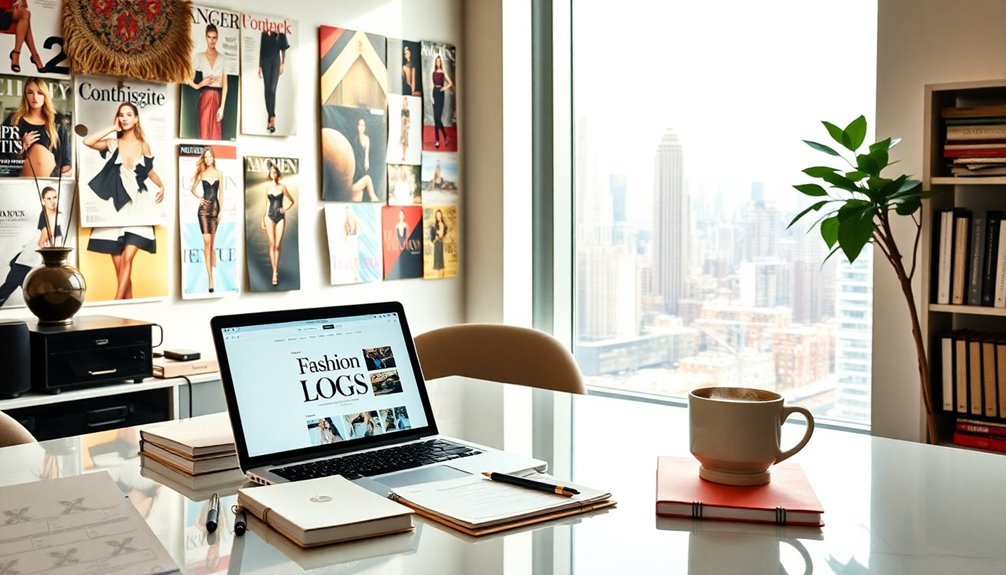
Gaining editorial experience is crucial for aspiring fashion editors looking to make their mark in the industry. Start by building a strong portfolio that showcases your previous work in fashion editing or writing. Include edited articles, story ideas, and other relevant content, emphasizing your trend-spotting abilities and fashion knowledge. Regularly update your portfolio to reflect current trends and your evolving skills. Next, seek out internships or freelance opportunities with fashion publications, where you can gain hands-on experience and learn from experienced editors. Networking with professionals in the industry can also provide valuable insights and opportunities for growth. Additionally, consider taking courses or workshops focused on fashion magazine writing tips to further refine your skills and stay up to date with industry standards. By continuously building your editorial experience and honing your craft, you can position yourself for success as a fashion editor.
Internships are invaluable for gaining practical experience. Secure positions with fashion publications, magazines, or websites as a fashion writer or assistant editor. These roles help you build foundational skills and network with industry professionals. Fashion Editors must stay updated on emerging trends, so seek opportunities that allow you to explore various aspects of the fashion world. Apply for as many internships as possible, even in different departments, to learn about the entire content creation process.
Additionally, managing teams and projects is vital. Gain experience in delegating tasks, communicating effectively, and supervising projects like story planning and photo shoots. Learn to coordinate with photographers and models, and manage budgets related to editorial projects.
Lastly, prioritize networking. Attend fashion shows and industry events to build relationships with designers, models, and photographers, using these connections to stay informed about new trends and developments.
Understanding Fashion Industry Dynamics

Understanding the dynamics of the fashion industry is essential for any aspiring fashion editor aiming to thrive in a competitive landscape.
You'll need to grasp the economic challenges, like sluggish growth projected at low single digits by 2025. Consumer sentiment is shaky, with only 20% of fashion leaders expecting improvements, while inflation has made shoppers more price-sensitive, directly impacting apparel demand. In addition, the non-luxury segment is projected to drive economic profit increase for the first time since 2010, highlighting a potential area for growth amidst the uncertainty.
Geopolitical instability and economic volatility are also significant headwinds, with 62% of executives citing these as major risks.
You'll notice regional disparities—while Europe and the US see slow growth, India shows rising consumer confidence. Additionally, China's market performance has fluctuated, affecting global trends.
As consumer behavior shifts, you'll find that sustainability remains a priority, despite consumers' reluctance to pay more for eco-friendly products.
Trends like athleisure and casualization are reshaping preferences, demanding your attention.
Finally, keeping up with environmental regulations is crucial. The industry is prioritizing transparency and strategic partnerships to navigate supply chain challenges.
Understanding these dynamics will equip you with the insights needed to excel as a fashion editor and make informed editorial decisions.
Essential Skills for Fashion Editors
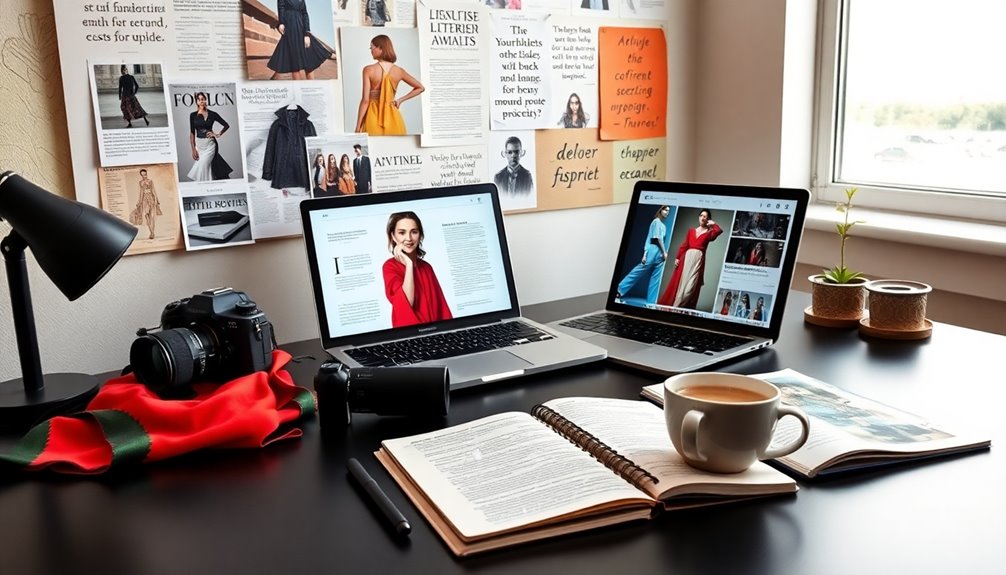
As you embark on your journey to become a fashion editor, mastering essential skills is crucial for standing out in this competitive field. You'll need proficiency in photo shoots, from planning to execution, and know how to assist on set. Familiarity with Adobe Photoshop and other creative software is a must, as you'll be developing unique editorial concepts.
Understanding how to create and style content for both print and online platforms will help you adapt to various media. Strong communication and interpersonal skills will also be key. You'll need to write clearly and speak effectively, collaborating with different departments and building professional networks.
Managing staff writers and liaising with media talent demands a keen ability to communicate. Attention to detail is vital for maintaining consistency in branding and editorial content. You'll have to juggle calendars, plan editorial content, and meet tight deadlines while ensuring accuracy in your articles.
Finally, digital and media literacy, including SEO and social media savvy, will enable you to create engaging online content and navigate platforms like Instagram and Twitter confidently. Additionally, honing your skills in quality control will ensure that all editorial content meets established guidelines and standards. Embrace these skills, and you'll be well on your way to a successful career as a fashion editor.
Building a Strong Portfolio
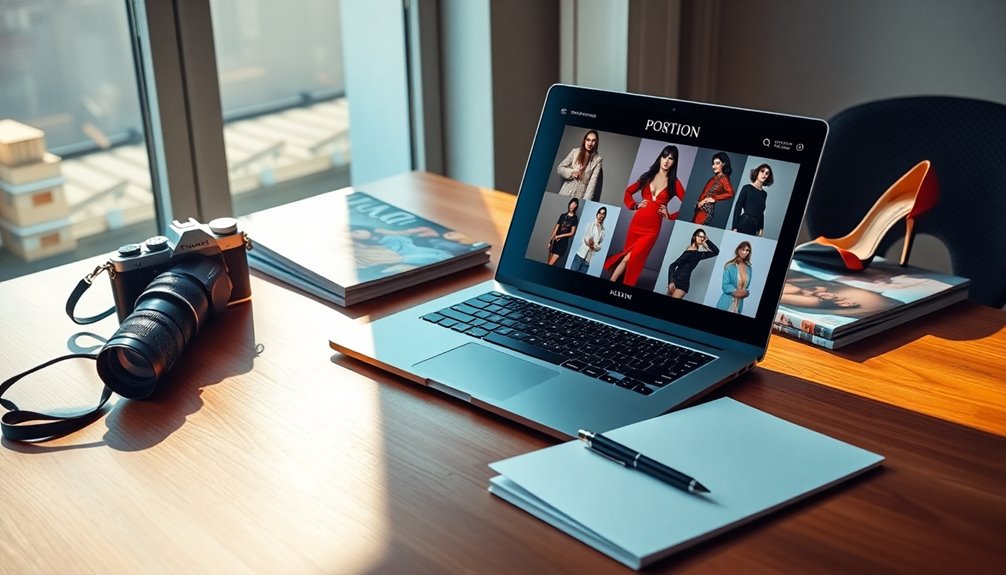
With the right skills in place, it's time to focus on building a strong portfolio that truly reflects your talent and vision as a fashion editor. Start by selecting and curating work that showcases your creativity and technical proficiency. Include published pieces—like magazine spreads—to highlight your professional accomplishments.
Don't forget to add research samples, such as notebooks and sketchbooks, to illustrate your creative process. Label each piece with a brief explanation to give context, ensuring potential employers understand the mediums, techniques, and your problem-solving strategies. Highlight the story behind each project to engage your audience further. Additionally, a well-crafted portfolio should also illustrate knowledge of visual communication and design principles to enhance your storytelling.
When deciding on the format, use appropriate paper sizes for physical portfolios and create a digital version for online sharing. Choose a user-friendly website builder, organizing your projects by category or date for easy navigation. Prioritize a simple, professional layout.
Lastly, present your portfolio with high-quality images optimized for the web. Share it on platforms like LTK & ShopShare and leverage social media to boost visibility. This way, you can effectively showcase your work to potential employers and clients.
Networking Strategies in Fashion
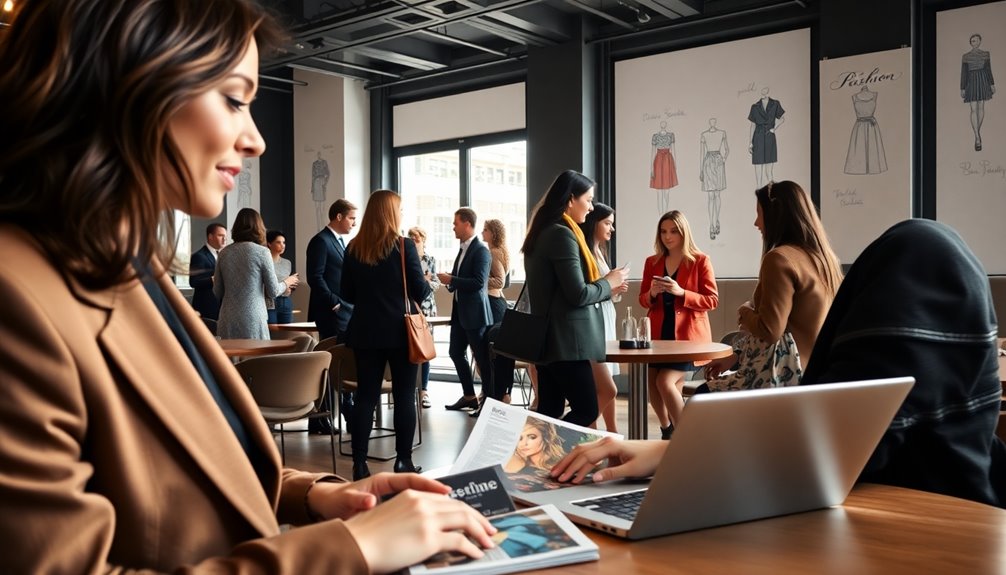
Networking in fashion is crucial for carving out your path as a fashion editor. Attend industry events like fashion shows and parties to meet key players, designers, and stylists. High-profile gatherings, such as the Sustainable Fashion Forum or the SM Global New York AW25 Gala, are prime opportunities to connect with influential professionals.
Create and leverage your online presence by engaging with fashion communities on platforms like Instagram, TikTok, and LinkedIn. Join fashion-related groups and follow brands and photographers to expand your network. Networking is essential for discovering new opportunities and advancing your career in this competitive field.
Don't forget to build a database of contacts and keep track of their email addresses for future outreach.
When engaging with new contacts, approach them with questions or compliments to break the ice. Introduce yourself to everyone, from interns to CEOs, as everyone can have valuable connections.
After events, follow up to maintain relationships and express genuine interest in their work.
Finally, practice active communication and seek mutually beneficial partnerships to strengthen your network. By sharing knowledge and offering help, you'll foster strong relationships that can open doors in your fashion career.
Career Path and Progression
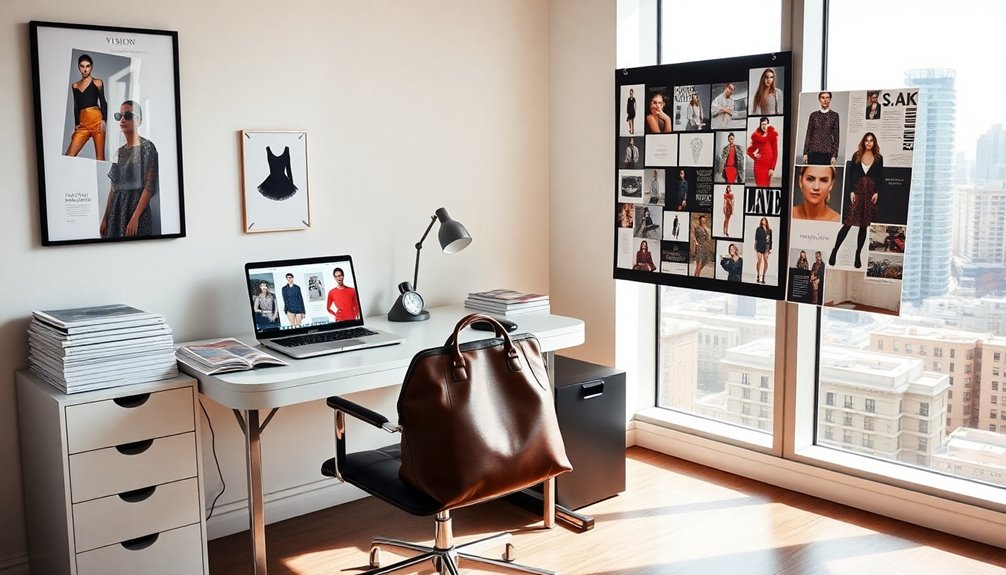
Building a network in the fashion industry sets the stage for your career progression as a fashion editor. Begin by pursuing a degree in fashion journalism, communications, or a related field to build a solid foundation. Renowned institutions like New York University and Parsons School of Design offer programs that can give you an edge.
Consider starting your journey as an editorial assistant, where you'll help organize the magazine, assist with design, and manage photo shoots. Gaining experience through internships is crucial; they provide practical insights and industry exposure. Internships at fashion magazines often lead to valuable connections and opportunities in the field.
As you progress, you can move up to roles like editor's assistant, gradually taking on more significant editorial duties. Your focus will shift from minor stories to important fashion news and features. Promotions often lead to positions with greater responsibility, such as managing editor or editor in chief.
To stand out, develop key skills like creativity, attention to detail, and strong writing. Keep your portfolio updated and showcase your best work. Finally, stay current with fashion trends and embrace technology to enhance your content and audience reach, ensuring you remain relevant in this dynamic industry.
Management and Leadership Skills
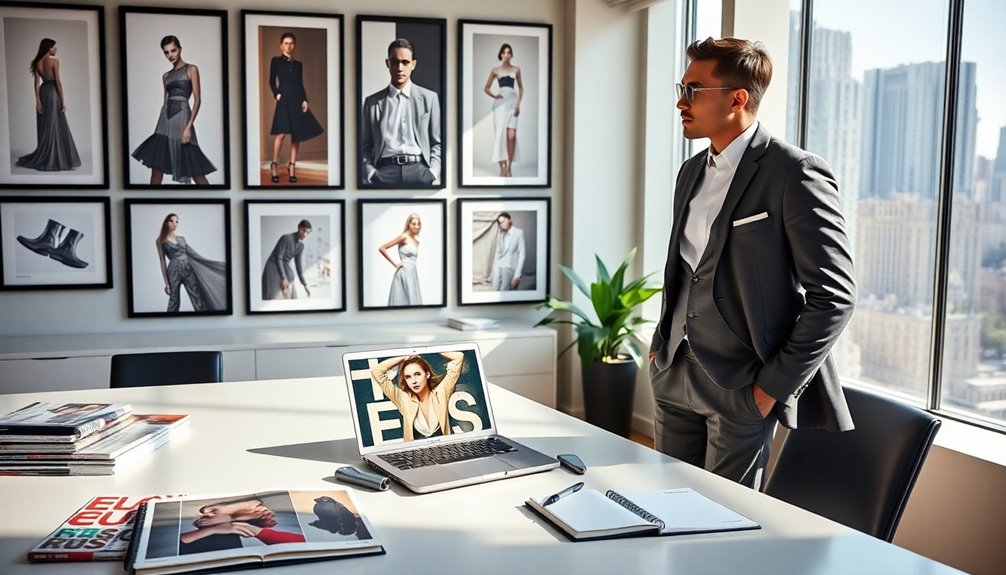
Management and leadership skills are essential for a successful fashion editor, as they directly impact the quality and efficiency of your publications.
You'll need to coordinate and communicate with photographers, models, makeup artists, and costume designers to ensure a seamless production process. Supervise and manage the magazine layout while collaborating with journalists, fashion experts, and other team members to produce cohesive content.
Effective leadership means inspiring your team by example, showcasing impeccable work and style. You must communicate clearly and leverage multimedia to create engaging content. Be open to your team's creative ideas, ensuring fresh and innovative publications. Additionally, having extensive knowledge of fashion industry trends helps you guide your team more effectively.
Delegating tasks efficiently is crucial; you'll foster teamwork among designers, writers, photographers, and models to bring your vision to life.
When challenges arise, you need to make informed decisions and solve problems swiftly, especially during tight deadlines or last-minute changes.
Staying Current With Trends
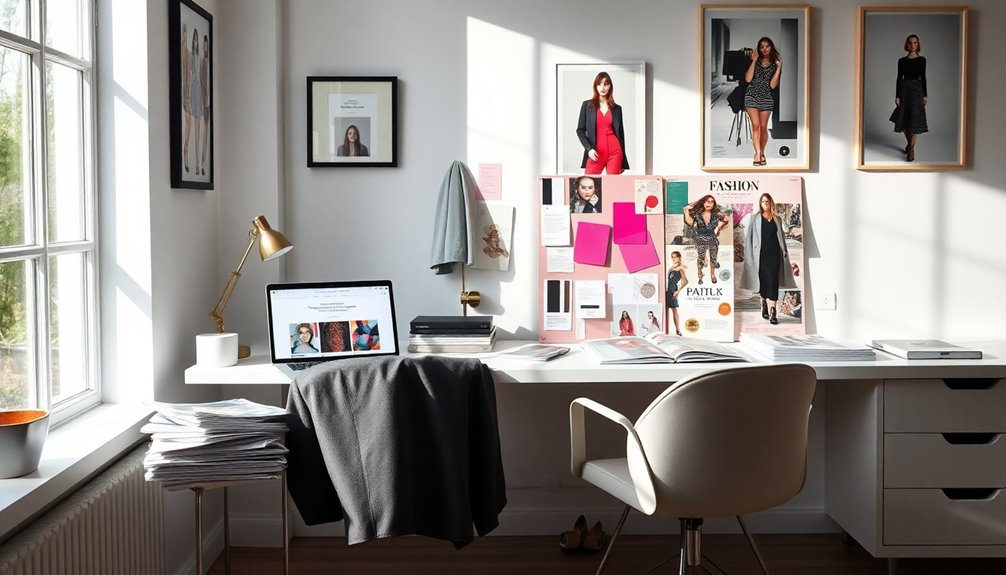
To thrive as a fashion editor, you must stay ahead of the trends that shape the industry. Start by closely following runway shows and fashion weeks, as they reveal shifts like the current move from minimalism to maximalism. Look for key colors—powder pink is making waves—and pay attention to the luxurious, over-the-top designs that dominate the scene.
Next, monitor industry shifts and innovations. Sustainability is crucial; focus on circular fashion systems and biodegradable materials. Keep an eye on smart clothing trends, such as temperature-regulating fabrics and the rise of gender-neutral fashion, which is projected to reach $1.6 billion by 2025. Additionally, the increased use of biodegradable materials in fashion design underscores the industry's commitment to sustainability.
Engage actively with digital and social media. Fashion publications rely on fresh content driven by social media trends and industry news. Utilize SEO strategies to enhance your articles, making them more discoverable.
Finally, understand consumer behavior. With rising inflation, shoppers prioritize high-quality, durable items and seek sustainable, ethically produced products.
As online sales grow, reimagining retail stores and integrating personalized experiences will be vital. Stay informed, adapt to changes, and you'll excel as a fashion editor.
Frequently Asked Questions
What Is the Average Salary of a Fashion Editor?
The average salary of a fashion editor in the U.S. is about $60,537 per year, with entry-level positions starting around $30,000 to $50,000.
If you gain more experience, you could earn significantly more, with top editors reaching six-figure salaries.
Geographic location plays a big role, too, as cities like New York and Los Angeles offer higher pay.
Are Internships Necessary for Becoming a Fashion Editor?
Internships are crucial if you want to become a fashion editor. They give you hands-on experience, letting you learn the daily nuances and lingo of the industry.
You'll get to assist with tasks like writing and scheduling photo shoots, while also building valuable networks. Those connections can lead to future job opportunities.
Plus, internships help you develop essential skills and enhance your resume, making you a more attractive candidate for editorial roles.
How Important Is Personal Style in This Profession?
Personal style's incredibly important in the fashion industry. It reflects your professional image, boosting your confidence and helping you stand out in a crowded field.
A strong personal brand can make you appear more trustworthy and competent. Plus, having a keen eye for trends allows you to curate content that resonates with your audience.
Ultimately, your style can shape how others perceive your professionalism and creativity, making it essential for success.
Can I Become a Fashion Editor Without a Degree?
Yes, you can become a fashion editor without a degree, but it's challenging.
You'll need to build relevant experience through internships or entry-level roles. Focus on developing strong writing and editing skills, and create a portfolio showcasing your work.
Stay updated on fashion trends and network with industry professionals.
While a degree can be beneficial, practical experience and a deep understanding of fashion can help you succeed in this competitive field.
What Are Common Challenges Faced by Fashion Editors?
As a fashion editor, you'll face numerous challenges.
You're constantly under pressure to maintain a specific image, which can lead to self-doubt and stress. The industry's fierce competition means you'll encounter frequent rejection, necessitating resilience.
Financial instability might complicate your creative vision, as you juggle tight deadlines and budget constraints.
Navigating blurred lines between editorial and sponsored content can raise ethical concerns, testing your integrity while maintaining relationships with brands and designers.
Conclusion
Becoming a fashion editor takes dedication and a proactive approach. By focusing on your education, gaining hands-on experience, and honing your skills, you'll set yourself up for success. Don't underestimate the power of networking and building a strong portfolio to showcase your work. As you navigate your career path, stay updated on industry trends and develop management skills to elevate your position. With passion and perseverance, you can climb the media ladder and make your mark in fashion.
